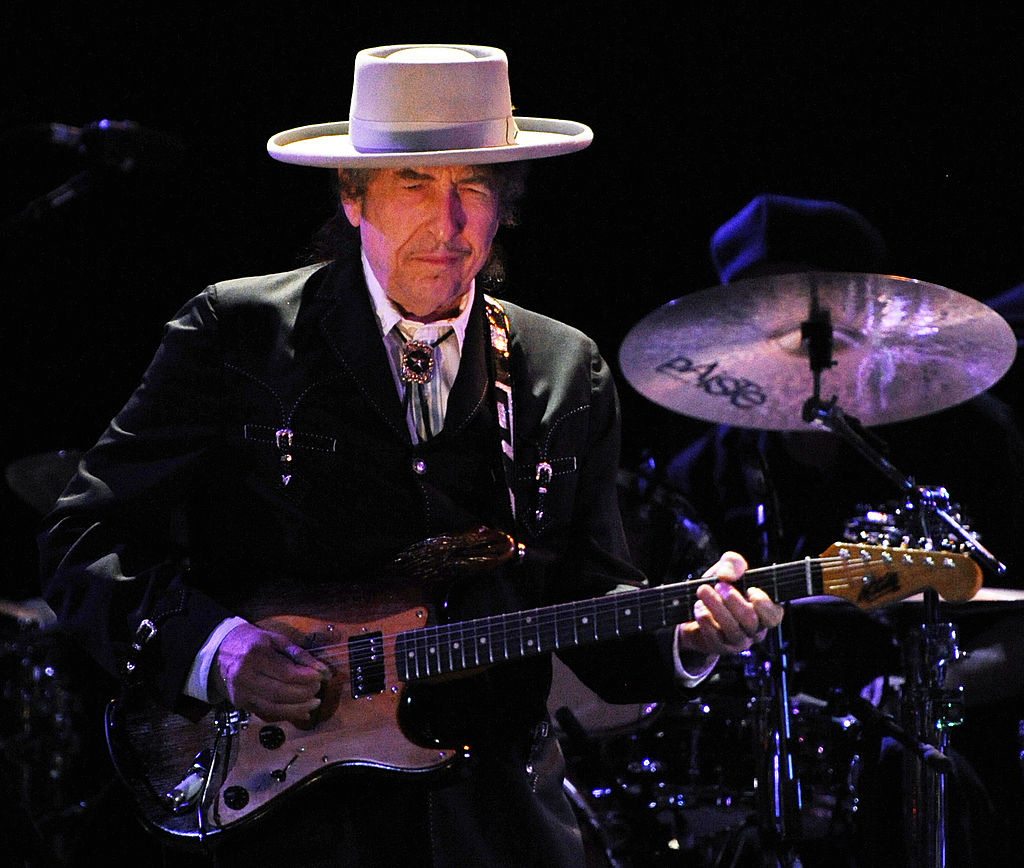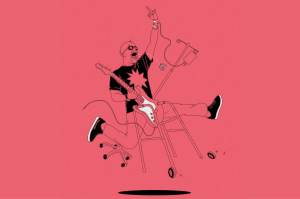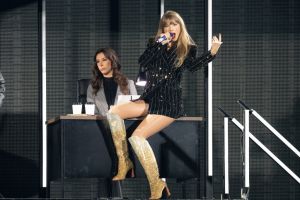Bob Dylan has just concluded the first leg of his revitalized “Never Ending Tour,” which was paused, along with the world, after March 2020. Scheduled to travel to Japan last April, Dylan canceled his dates in Tokyo and Osaka, and presumably sheltered at home in California.
He wasn’t resting, though. Just after midnight on March 27, 2020, his website posted a nearly 17-minute-long song, “Murder Most Foul,” circling around and about the assassination of President John F. Kennedy. Excited rumors of a record of new Dylan songs proved true when Rough and Rowdy Ways, his 39th studio album, was released on June 19, 2020. A year and a half later, Dylan and a newly constituted band finally took the record on tour.
“The Rough and Rowdy Ways Tour 2021-2024” began in Milwaukee, Wisconsin on November 2, 2021. Expectations and protocols were both high. Venues required proof of vaccination against Covid, or recent negative tests; all recommended, and a few mandated, masks.
Dylan and his band consisted of longtime stalwarts Tony Garnier on bass and Donnie Herron on keyboards and steels, new hires Bob Britt and Doug Lancio on guitar, and Charley Drayton on drums. Dylan played an upright piano. His piano playing these days is rough and ready and rowdy itself, sounding like the mating of boogie-woogie and barrelhouse jazz under a table in a saloon in Dodge City, back in the day.
The band began with an almost muffled “Watching The River Flow” and a new arrangement of Dylan’s 1966 classic “Most Likely You Go Your Way (and I’ll Go Mine).” Then the Rough and Rowdy Ways heart of the set began. The band played all the songs on the record save two: the gritty, classical-laced “Crossing the Rubicon,” which would have fit well into these set lists, and “Murder Most Foul.” The rollicks “False Prophet,” “Early Roman Kings” (from Tempest, 2012) and “Goodbye Jimmy Reed” alternated with slow ballads like “Key West (Philosopher Pirate),” “Mother of Muses,” “Melancholy Mood” (the only cover song in the set), and “I’ve Made Up My Mind To Give Myself To You.”
The Milwaukee show ended with the double whammy of “Love Sick” (1997) and the 1965 blues wail “It Takes A Lot To Laugh / It Takes A Train To Cry.” Just a few days later, Bob and the band axed these last two songs and settled into his 1981 spiritual “Every Grain of Sand” as the closer. For the next month, ending on a triumphant note at the Anthem Theater in Washington, D.C. on December 3, Dylan played 21 sold-out shows across the Midwest, mid-Atlantic, and Northeast.
An 80-year-old Nobel Laureate in Literature who has spent the lion’s share of his nights performing on a stage, and who is far wealthier than most entertainment stars alive after the sale last year of his music catalogue to Universal Music Publishing Group, has nothing to prove to anyone. What compels Bob Dylan to be out in his customized brown, black, and tan tour bus? The answer, it seems to me, is in the title of one of his recent songs that he sang every night: “I’ve Made Up My Mind To Give Myself To You.”
The feeling is also inherent elsewhere in the carefully chosen set list; increasingly, that night’s particular audience was the “you” in every song. To be alone with you? He’s up for that. His own version of you? He’s composing that nightly, from different audiences all over the map. Tonight, he’ll be staying here with you? Yes, he will, at least for awhile. Sure, the tour sold tickets — but Dylan doesn’t need the money. Sure, every night received great reviews — but he doesn’t need critical acclaim.
Dylan is not the voice of a generation, that ancient tagline that has always seemed to annoy him most because of its inherent limitation. He’s become the voice of generation. The Janus-faced songs on Rough and Rowdy Ways, looking back into the past to show the way forward, are utterly unconstrained by artificially marked human decades, into any categories under which their listeners meekly say they belong, Boomers and Gen X and Gen Z. Like his fellow Laureate William Butler Yeats, Dylan is rising into greater force and power as he ages. His circus animals haven’t deserted him any more than Yeats’s did; his command of words and symbols and rhyme becomes vaster and keener, year by year.
The power and magic of Dylan’s shows this time around was in the open-armed acceptance of the new songs, and in the energy between relieved and delighted audiences, and visibly and audibly happy performers playing well together. After the annus horribilis of 2020, after so much fear and stress, loss and grief, Dylan’s giving us all, and perhaps himself, a break. Like the album on which it is almost entirely based, the Rough and Rowdy Ways Tour is, in a word, generous. It’s a gift.
Dylan was first known as a ballad singer, and then he became a rock star. That mid-1960s evolution is showcased, now, in terms of style: the ballads are rock-rimmed, even the good old songs. He’s altered them, not beyond recognition, but it’s a funhouse mirror recognition. “I’ll Be Your Baby Tonight” is, in its original album incarnation on John Wesley Harding (1967), a genial little carpe diem accompanied by plunky guitar and a swoony pedal steel. Today, you could do a fine striptease to the tune, with its bumping, grinding guitars — and Garnier’s bass in particular serves up some solid 1970s-porn-soundtrack boomph — and a ba-ba-da-daah, flourishy ending.
Similarly, “To Be Alone With You,” which appeared on Nashville Skyline (1969) as a delightful ditty anticipating a lovers’ reunion at night after a hard day’s work, is that no more. Now it’s coarser, funnier, and raw, both in the tune and the words. Dylan debuted most of the rewritten lyrics he’s been singing live — likely an outgrowth of the rewrites in his Mondo Scripto art show of 2018, and his longtime penchant for changing lyrics in performance — in his filmed Shadow Kingdom performance of July 2021:
I wish the night was here
Make me scream and shout
I’ll fall into your arms
And let it all hang out
I’ll hound you to death
That’s just what I’ll do
I won’t sleep a wink
Till I’m alone with you.
In concert, he lingers on that “let it alllllllllll hang out,” and relishes biting off the “hound you to death.”
What happened to me, darlin’?
What was it ya saw?
Did I kill somebody?
Did I escape the law?
My heart’s in my mouth
My eyes are still blue
My mortal bliss
Is to be alone with you…
In Washington, on the final couplet in the refrain, Dylan put in an “ee” before the “mortal”: “My immortal bliss / Is to be alone with you.” Then he grinned.
The 6,000-seat Anthem is a riverfront cement box that manages, within, to echo an old vaudeville or moving-picture palace. Dylan and the band gave a show there last Thursday that was, of all the gigs I heard live, tied for best with Boston’s. Washington gets the edge, though, for it was the final night. Dressed in a black suit with Western-style detailing, Dylan walked onstage punctually for the 8 p.m. show, though there were still lines of people outside grappling with vaccine cards, identification, and wristbands.
He spent much of the show behind his upright piano, but was never for a moment static. He shifted on the piano bench. He sipped from a black ceramic cup (hot tea with honey?) and a taller paper cup (of water). He stood up and scratched his head vigorously a few times. He smiled a lot, and looked out at the crowd between songs. At one point, he sat on an amp next to Garnier. For “Melancholy Mood,” his swingy version of the 1939 classic made famous by Artie Shaw and Frank Sinatra, and for his band introductions, Dylan emerged from behind his sheltering piano and stood in plain view of most of the house, microphone in hand. He cued the band individually; all eyes are on him at all times. During “Key West (Philosoper Pirate),” he gave Herron a direction, and the passionate swell of the accordion softened. During “Mother of Muses,” he nodded several times at Drayton, who took up a whole set of sizzle chains, like a cat o’nine tails, and gave his cymbals the lightest brush imaginable. Drayton is a superb addition to the band; his touch and playing comports so well with Dylan’s voice and delivery, never overpowering as drums and bass can too often do, but complementing and accompanying.
Dylan seemed happy to be in our nation’s capital, addressing the audience not once but twice — after years of no talking onstage, he’s been downright loquacious on this tour. The “Bob Talk,” should you wish to find it, is well chronicled at the leading Dylan fan site ExpectingRain.com. He referred in every city to landmark buildings, native sons, neighborhoods, historical events, celebrated musicians. In Washington, he first spoke to make a joke after smoke had rendered him only dimly visible. Smoke or dry ice was used on the tour to create atmosphere — and, I would guess, to obscure the stage from all the people who just won’t stop violating the clearly stated no photos/no video/no recording policy. However, the atmosphere stirred up during the long, dark “My Own Version of You” was excessive. “Well, thank ya, friends,” Dylan said during the applause after the song, fanning his long fingers and waving his expressive hands through towering clouds of haze. Then he joked that Foggy Bottom must be somewhere near — it’s the low-lying part of town just upriver, home to many State Department buildings, George Washington University, and the infamous Watergate.
“Watching The River Flow,” the opener, was something of a warmup, for both the instruments and Dylan’s voice. It worked. “Most Likely You Go Your Way (and I’ll Go Mine)” was full throttle, and the performers kept the needle at 11 for the rest of the night. “When I Paint My Masterpiece” is now a croony 1930s swing, with very altered words. One of my favorite Dylan rhymes has always been “Sailing round the world in a dirty gondola / Oh, to be back in the land of Coca-Cola.” This cynical traveler’s observation is now gentled into “Lookin’ over the world full of crimson and clover / Sometimes I think [that] my cup’s runnin’ over.”
“False Prophet” was a standout. Dylan stood up and snarled and yowled the savage, assertive lyrics, often smiling as he did so. People sprang up to dance, and whoop in response to the ends of every line, as he sang:
I’m first among equals — second to none
The last of the best — you can bury the rest
Bury ‘em naked with their silver and gold
Put them six feet under and then pray for their souls….
You know darlin’ the kind of life that I live
When your smile meets my smile — something’s got to give
I ain’t no false prophet — naw, I’m nobody’s bride
Can’t remember when I was born and I forgot when I died.
Then he grinned again. Dylan deploys, and I do mean deploys, the word “darlin’” on several of his new songs. You flinch and step back, even as you like it.
He’s also fond of the figure of the singer as seer, as oracle. In performance, he’s not just oracular but commanding, whipping out the words, giving orders he expects to be obeyed. The addressee of “Black Rider” better listen up. The slow, sung-spoken song was full of gravel and grit, sass and scorn: Dylan spat out the words, directed at every corrupt politician, every tinpot dictator, every wannabe emperor. He punches out the edgiest lines on “I Contain Multitudes.”
Long gone are the days of the early nineties, of people complaining they couldn’t understand what he was singing, couldn’t make out the words. Gone too are the early 2000s, when Dylan’s voice was drowned out by the bass being turned up too high, by pounding drums. His enunciation is as clear as Professor Henry Higgins’s, and his voice loud and strong on the rock and roll and lyric ballads alike. Honestly, there’s something imperial about his performances and songs these days. When he asks himself what would Julius Caesar do, that sounds like a real question. Conquer and civilize: art can do that as well as armies. Maybe better.
“Key West (Philosopher Pirate)” was my favorite song when I first heard the new album in May 2020, and it rose slowly to great beauty in live performance. The song was astounding in Boston and in Washington, from Dylan’s carefully phrased lyrics to Herron’s accordion and the swell of all the instruments in union on the refrains. Playing with Dylan, I’ve long thought, must be like being the little dog, Nipper, in the old RCA Victor advertisement. Listening to his master’s voice, Nipper cocks his ear attentively. Dylan’s drummers, guitarists, all his sidemen are in the same boat as Nipper: listen to that voice and where it’s going and when, or a song fast becomes chaotic. This band has it down pat. Dylan doesn’t shake them off or slip away. He seems to be enjoying this care, and the excellent sound it engenders, joking with his band between numbers, and generous, even affectionate, in his nightly introductions.
The sheer enchantment of “Key West” was broken by a smashing “Gotta Serve Somebody.” A note to critics who would confine Dylan’s “Gospel period” to 1978-1981: his gospel days began when he was a boy in Minnesota, listening to Mavis Staples and The Staple Singers; they intensified with his own religious conversion in 1978 or 1979; and they continue today. As he performs “Gotta Serve Somebody,” it’s a camp meeting jubilation, while “Every Grain of Sand” is a benediction, with the rise and fall of his voice on the title line in the refrain an exact slice of a good old sevenfold amen.
The lengthily and comprehensively entitled “I’ve Made Up My Mind To Give Myself To You” was one of the most popular songs every night. When Dylan sings,
I’m giving myself to you, I am
From Salt Lake City to Birmingham
From East L.A. to San Antone
I don’t think I could bear to live my life alone…
the crowd takes it personally, and reassures him that we’re all here with him, giving ourselves right back in return. The lost-love cover of “Melancholy Mood” came next in the set list, giving way to “Mother of Muses.” This, too, is a song of “a love too soon to depart,” but that’s almost beside the point, given the sweep of American history from the Civil War to Civil Rights that Dylan spans. He celebrates warriors like William Tecumseh Sherman and George Patton,
Who cleared the path for Presley to sing
Who carved out the path for Martin Luther King
Who did what they did and then went on their way
Man, I could tell their stories all day…
He may be “falling in love with Calliope,” but he isn’t quite ready to commit to the lyre-wielding singer of epic poetry just yet. The addressee of the superb last stanza, interwoven with quotations and echoes from hymns and poems, is still her mother:
Take me to the river and release your charms
Let me lay down in your sweet lovin’ arms
Wake me — shake me — free me from sin
Make me invisible like the wind
Got a mind to ramble — got a mind to roam
I’m travelin’ light and I’m slow coming home.
“Goodbye Jimmy Reed” is one of the most hard-rocking numbers Dylan’s written for years. Even in the more posh and sedate theaters, or theatres, people got up and moved to this one. Would you stomp and clap harder if you knew anything about Mathis James Reed of Dunleith, Mississippi? That he was one of the most electrifying, and among the first electric, blues guitar players of Dylan’s youth? Dylan likes to instruct his listeners in the music he loves; his entire Theme Time Radio Hour series for satellite radio illustrates this in every episode. “Goodbye Jimmy Reed” is both danceable and didactic, which is perhaps only possible in Dylan’s hands; it ends with a double tribute, first to bluegrass legend Bill Monroe’s “Can’t You Hear Me Calling” (1949), and a last shout-out to Reed, and his 1969 album Down In Virginia, the title track of which was written by his wife and backup singer Mary Lee “Mama” Reed.
After “Jimmy Reed,” Dylan introduced his band, they concluded with “Every Grain of Sand,” lined up and acknowledged the audience briefly, and he was out of the building while the applause went on and on, well before the lights came on again. When he comes out from behind the piano for his final bow, Dylan moves lightly on the balls of his feet, like a cat. During the show, he stretches and squats and struts. He does a sassy little knees-bent half turn. He gestures and beckons and even gives a hint of music-hall jazz hands. He moves like no 80-year-old I know.
I hope Dylan takes off some solid time to relax and enjoy the holiday season. However, I don’t think he’s tired: he relishes this, and lives off it. The enjoyment he and his band — “the boys,” he called them sometimes — are taking in The Rough And Rowdy Ways Tour is not only evident but infectious. Go. Be moved. Dance as if we all lived in better days, and maybe we will.
*all lyrics, published and performed, © Special Rider Music, 2020 and 2021.


















